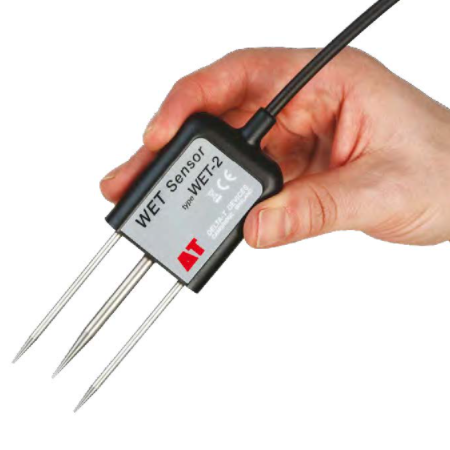· Moisture
and nutrient status in the root zone
· Rapid
monitoring of growing conditions
· Calibrations
for many soils and substrates
The WET
Sensor has crucial applications in precision horticulture and soil science
research and is usable in both soils and growing substrates. It is exceptional
in its ability to measure pore water conductivity (ECp), the EC of the water
that is available to the plant.
Rapid checks on growing
conditions
The sensor is easily inserted into substrates, composts and most
soils. It takes less than 5 seconds to measure water content (%), pore water
conductivity (ECp) and temperature – all being important indictors of root zone
health.
Pore
water conductivity
The WET Sensor is able to calculate pore water conductivity
(ECp) which is the EC of the water available to plant roots. The ECp
calculation is derived from an approximate relationship between dielectric
properties. This applies particularly well to WET Sensor readings, which are
taken at the same frequency within the same defined region of soil/substrate.
The approximation is valid in most soils and is particularly accurate in
mineral wool and other artificial substrates media.
Fertigation
and hydroponics
Where plants are grown in artificial substrates using hydroponic
or fertigation systems, nutrients are routinely supplied in irrigation water.
Nutrient levels are controlled by monitoring the water content and conductivity
(EC) and adjusting the injection of liquid fertiliser into the irrigation
water. The Delta-T Devices WET Sensor excels in monitoring this crucial
information.
Container-grown
shrubs and trees
Nutrients are sometimes provided by fertigation but are often
provided by Controlled Release Fertilisers (CRF). The rate at which these are
taken up depends on several factors, including the weather conditions and
irrigation regime.
The Delta-T Devices WET Sensor can be used to measure the EC within the growing
media and so take much of the guesswork out of this process.
Soil
salinity
If the irrigation water is recycled or abstracted from rivers
and aquifers with high levels of dissolved salts, over time there can be a
build up of soil salinity. Soil salinisation will eventually reduce crop
yields. The WET Sensor is fast and efficient for sampling soil salinity,
ensuring that farmers have the essential information they need to take remedial
action as quickly as possible.
Download
相關標簽
WET,Delta-T,Delta-T Devices

 Enquiry:hkmarketing@epc.com.hk
Enquiry:hkmarketing@epc.com.hk  Whatsapp Enquiry: +85261990717
Whatsapp Enquiry: +85261990717










